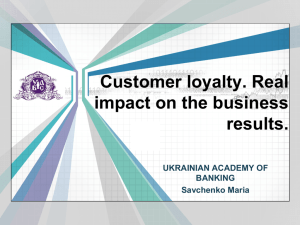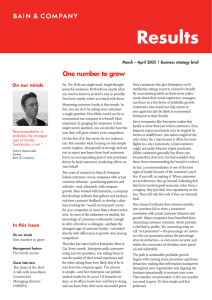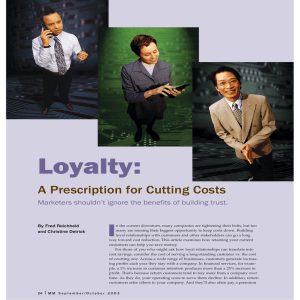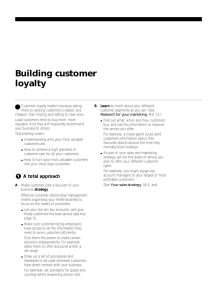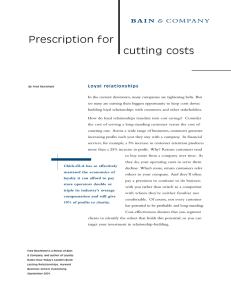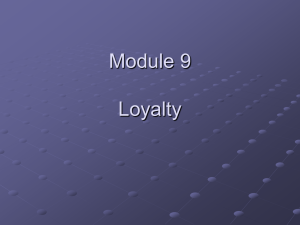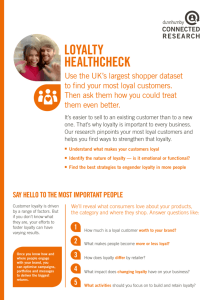Customer Loyalty: 7 Techniques to Build a Die-Hard Base
advertisement
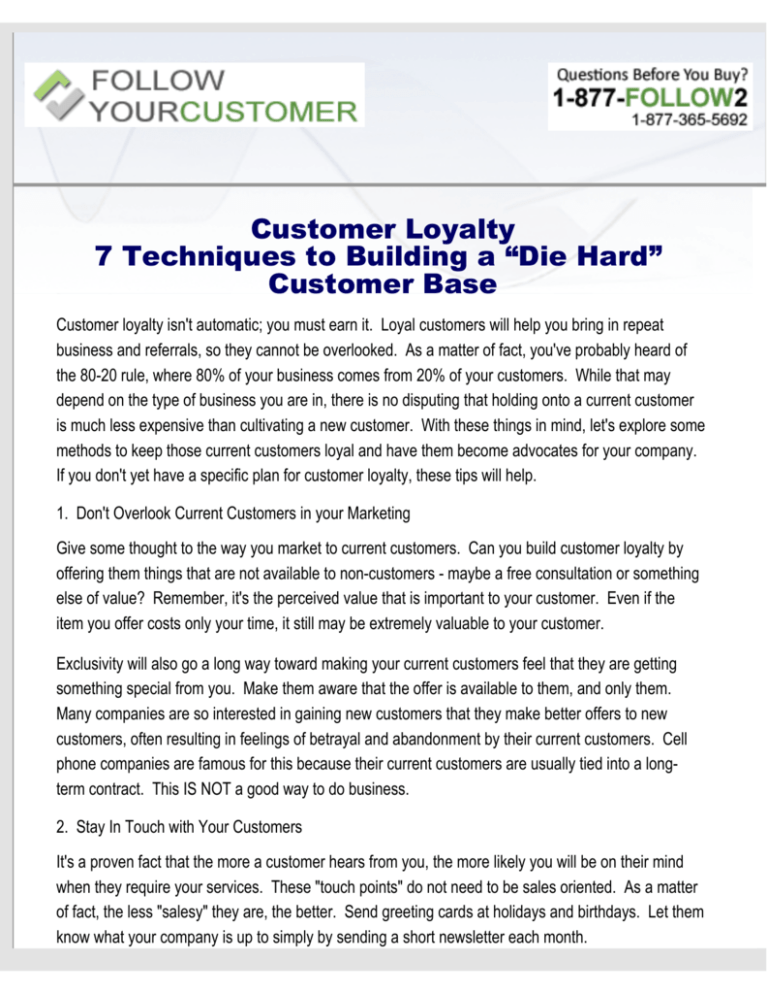
Customer Loyalty 7 Techniques to Building a “Die Hard” Customer Base Customer loyalty isn't automatic; you must earn it. Loyal customers will help you bring in repeat business and referrals, so they cannot be overlooked. As a matter of fact, you've probably heard of the 80-20 rule, where 80% of your business comes from 20% of your customers. While that may depend on the type of business you are in, there is no disputing that holding onto a current customer is much less expensive than cultivating a new customer. With these things in mind, let's explore some methods to keep those current customers loyal and have them become advocates for your company. If you don't yet have a specific plan for customer loyalty, these tips will help. 1. Don't Overlook Current Customers in your Marketing Give some thought to the way you market to current customers. Can you build customer loyalty by offering them things that are not available to non-customers - maybe a free consultation or something else of value? Remember, it's the perceived value that is important to your customer. Even if the item you offer costs only your time, it still may be extremely valuable to your customer. Exclusivity will also go a long way toward making your current customers feel that they are getting something special from you. Make them aware that the offer is available to them, and only them. Many companies are so interested in gaining new customers that they make better offers to new customers, often resulting in feelings of betrayal and abandonment by their current customers. Cell phone companies are famous for this because their current customers are usually tied into a longterm contract. This IS NOT a good way to do business. 2. Stay In Touch with Your Customers It's a proven fact that the more a customer hears from you, the more likely you will be on their mind when they require your services. These "touch points" do not need to be sales oriented. As a matter of fact, the less "salesy" they are, the better. Send greeting cards at holidays and birthdays. Let them know what your company is up to simply by sending a short newsletter each month. Make sure the information you send is useful because that will help build trust and strengthen the relationship. If they perceive that you are helping them, they will be more inclined to become loyal customers and advocates. 3. Be Sure Your Staff has "Bought In" to the Quest for Customer Loyalty Customers want reliability and familiarity. They are looking to build a solid relationship just as much as you are. They want to deal with people who know them and their preferences. They may even let you make a mistake now and then because it is easier to let you slide than "train" a new company to take care of their needs in the way they have taught you; this means that your company must have a loyal workforce. Constantly changing employees will do nothing toward building strong customer relationships. Follow this rule of thumb: If you treat your employees well, they will treat your customers well. 4. Know the Stages of Loyalty and React Accordingly It is a step-by-step process to grow customer loyalty; it won't happen over night. The six stages of loyalty are: Suspect - Prospect - First Time Customer - Repeat Customer - Client - Advocate Let's take a brief look at each stage. A suspect is someone who might have interest in what you are selling, but you don't have enough information about them to know for sure. A prospect is someone who definitely fits the profile of a customer who would buy your product or service. A first-time customer has purchased from you only once, while a repeat customer has been back two or more times. The client stage is where loyalty becomes most important. The mindset of a client is one of being "under your wing." They feel that you are looking out for their best interests and will not steer them wrong. Once you have moved your relationship to this point, the next stage is easy. Your customer becomes an advocate when they begin working to help you sell your product, whether they know it or not. They refer friends and acquaintances, always speak positively about you, and bring your name up without being prompted. Obviously, the client advocate is the greatest customer you could ask for! 5. Don't Sell Until They are Ready to Buy Customers today are better informed than ever. They have access to information that allows them to easily research and compare goods and services. They are also more intolerant than ever about being "sold to." They want to be treated with respect and they expect personalized and pleasant service. You can take advantage of this by keeping in touch with customers on a friendly basis and staying on their minds. When they are ready to buy, they will think of you. 6. Deal with Problems and complaints Immediately Most of the time, the customer rarely makes a complaint with the company. Instead they complain to their friends, neighbors, coworkers, and anyone who will listen. For this reason, it is important to follow up with your customers and make sure there are no complaints; if there are, you must attend to them immediately. Research shows that a dissatisfied customer is more than five times more likely to tell people about his negative experience than a happy customer will talk about their positive experience. However, you can turn the tables on an unhappy customer by fielding their complaint and solving the problem. How many times have you heard someone talking about how nice it was to have someone actually listen to their complaint and take care of it? The reason people talk about situations like that is because it is a personal victory for them and, they take ownership in getting it resolved properly. 7. Use Multiple Channels to Communicate and Stay Responsive with Your Customers Recent research suggests that customers who receive communication through different methods are more likely to remain loyal. Their perception is that you are making an effort to keep them informed and provide customer service using a variety of channels at your disposal. As long as the information is valuable and not sales-oriented, your customer will appreciate it. This is especially true in dealing with customer support issues. The moment you begin using email, postal mail, and phone calls for the "hard sell" is the same moment your customer begins looking elsewhere. You can use these seven tips to start gaining loyal customers right away! On occasion, you may want to come back and review this list to make sure you are still doing everything you can to create loyal customers. Keep an eye out for the next installment in the series where we "get into the heads" of buyers to find out what makes them tick. Best Regards! Follow Your Customer Inc.

